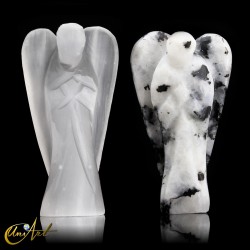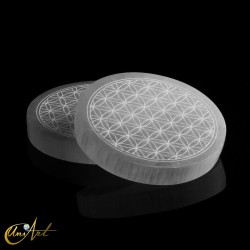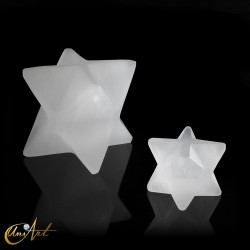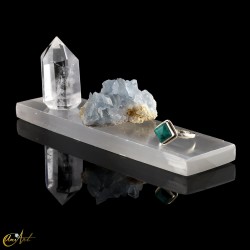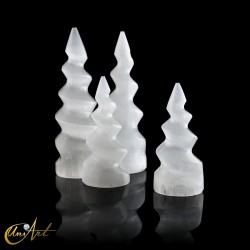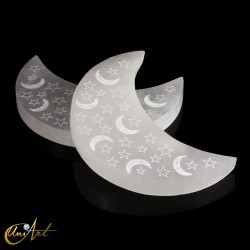Selenite: Properties, Meaning, and Uses
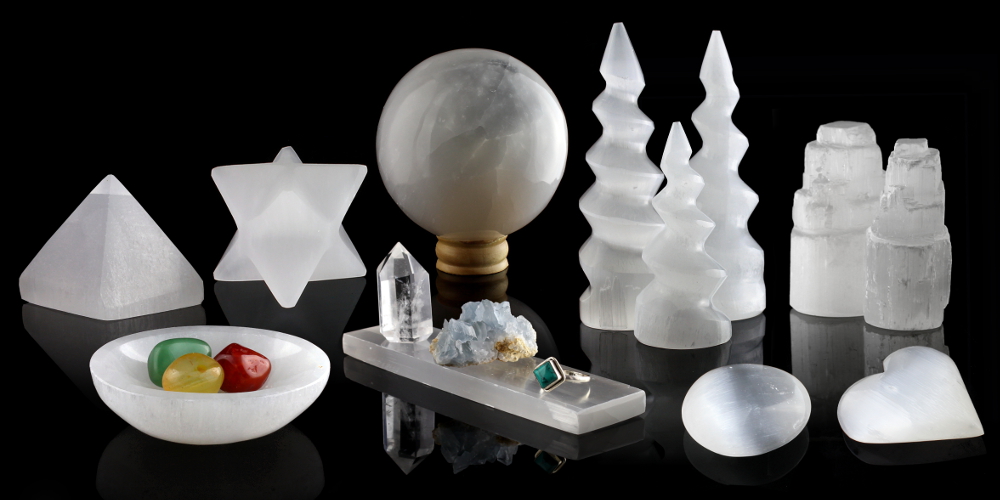
What is Selenite?
First, it is important to mention that the term "selenite" is used commercially to refer to satin spar gypsum, a white and translucent mineral. However, in geological terms, "selenite" is the name of a mineral that typically appears as colorless and transparent crystals. Both belong to the gypsum family and are primarily composed of calcium sulfate.
In this article, we will focus on "satin spar selenite," which is the most well-known and widely used variety today. This stone is appreciated for its unique physical and spiritual properties, as well as its characteristic satin luster and special luminosity.
Composition and Physical Properties of Selenite:
Selenite is a hydrated calcium sulfate, and although its most common color is white or colorless, it often exhibits golden, pink, and orange hues. Selenite crystals have a unique appearance resembling sugar bars, and their optical effect of satin luster gives them a special allure. Additionally, selenite can display a phenomenon called "cat's eye," which imparts a unique and linear luster as the stone moves under light.
Its relatively low hardness makes selenite vulnerable and delicate, but its characteristic exfoliation type makes it a marvel of nature. It has perfect exfoliation, meaning that selenite can be easily split into thin and flexible layers with relative ease. This makes it suitable for crafting decorative objects and sculptures, but it also increases its fragility.
The streak of satin spar selenite is white, similar to its color.
Formation and Deposits:
Selenite is a truly fascinating mineral found in various parts of the world, such as Mexico, India, and the United States. However, Morocco stands out as a significant producer, not only for the exceptional quality of its selenite but also for its economic significance in crafting artisanal products.
Selenite forms in specific geological conditions, often in areas with mineral-rich groundwater. The Cueva de Naica in Mexico is an iconic location that hosts impressive and gigantic selenite crystals, and its geological importance is unquestionable.
Meaning of the Name Selenite:
The etymology of the name selenite comes from the Greek goddess of the Moon, Selene, who personified beauty, benevolence, and lunar light.
The term selenite was introduced into mineralogy by Johan Gottschalk Wallerius, an eminent Swedish chemist and mineralogist from the 18th century. Wallerius used this term to refer to transparent gypsum, inspired by the gentle luminescence emanating from the stone, similar to moonlight.
Later, the same term has been commercially used for satin spar gypsum, as the name Selenite reflects the intrinsic connection of the stone with the moon, both in its energy and appearance. Its pearly luster evokes the delicacy and softness of moonlight on a clear night.
What is Selenite Used For?
Transparent selenite was used in ancient times as a substitute for glass. In ancient Rome, it was known as "Lapis specularis," which means "mirror stone," due to its specular properties and transparency. Although glass was already known at that time, selenite offered superior quality, flatness, and transparency for use in windows. Its unique ability to allow the passage of light made it valuable in architectural applications.
Satin spar selenite has been appreciated since ancient times by civilizations like the Persians, Greeks, and Egyptians. It was used both in the creation of decorative objects and jewelry and in the crafting of amulets and ritual objects.
Today, selenite is used in the production of a wide variety of items, primarily handcrafted, such as bowls, candleholders, and decorative objects. Its translucency makes it an excellent choice for decorative lamps. Additionally, it is found in costume jewelry and traditional jewelry, and it plays a significant role as a raw material in the gypsum industry.
Equally, we must not forget its extensive use in esoteric contexts.
Energetic Properties of Selenite in Esotericism:
Selenite holds a special place in the mystical and spiritual world due to its unique properties in the esoteric realm.
It is associated with lunar energy, light, feminine energy, and motherhood.
It is linked to the Archangel Gabriel and is used in interaction with the seventh chakra.
It is attributed purifying properties and is used in feng shui to harmonize environments and in meditation as an anchoring stone.
Selenite energetically cleanses other minerals and is used as diffusing lamps in color therapy.
Selenite is a fascinating natural stone with a world of properties and uses to explore. Whether you're looking for a unique gem or want to harmonize your surroundings, selenite has much to offer.
Discover the finest selenite products at UniArt.

